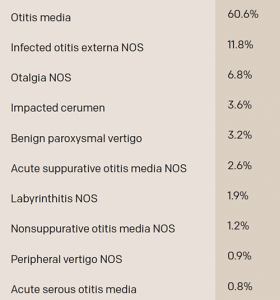
Most Common Otologic Diagnoses Made in the ED among All Patients with a Primary Otologic Complaint (2009-2011)
NOS, not otherwise specified
Source: Laryngoscope. 2015;125:1926-1933
Torree McGowan, MD, an emergency medicine physician at David Grant Medical Center in Fairfield, Calif., also said that it is rare for an ED patient with an ear complaint to have a true emergency. But mastoiditis and perichondritis, although uncommon, both present with ear pain and are justified emergencies. Lacerations involving the pinna are also injuries that must be repaired in a timely manner, to prevent deformity of the pinna caused by improper blood supply during healing. Auricular hematomas can create deformation of the pinna if not drained and dressed properly. Tinnitus can be caused by life-threatening conditions such as aspirin toxicity, carotid artery dissection or aneurysm, and anemia. Foreign bodies in the ear are usually fairly benign, unless they are button batteries, which can cause necrosis of the ear canal if not removed quickly.
Explore This Issue
September 2016Fever of unknown origin in a child younger than two years of age that originates in otitis media can result in meningitis, another true emergency, Dr. Chandrasekhar added.
Why Non-Urgent Patients Frequent the ED
Most patients with ear complaints are quickly evaluated and treated in EDs. “Multiple studies have shown that ED crowding, which is problematic at many hospitals nationwide, is affected by boarding admitted patients,” said Dr. Chandrasekhar. “Non-admitted patients with minor complaints actually have little impact on ED waiting times. However, on busy days, patients who present with ear complaints will likely be triaged to a lower triage category, because it’s rare that ear pain is life threatening. These patients may have prolonged waits for evaluation because other patients with potentially more life-threatening conditions are evaluated first.”

© sumroeng chinnapan / shutterstock.com
According to a report from the Centers for Disease Control, “Emergency Room Use among Adults Aged 18–64, January–June 2011,” the top reasons patients cited for going to an ED included lack of access to other providers (79.7%); seriousness of the medical problem (66%); only a hospital could help (54.5%); the doctor’s office wasn’t open (48%); and the problem was too serious for a doctor’s office (42.5%) (report available at cdc.gov).
“Business hours only account for 27% of a week’s hours,” Dr. McGowan said. “For the remaining 73% of the time, EDs are often the only places open when patients are in pain or are concerned about their health. Further, we are forbidden by The Emergency Medical Treatment and Labor Act (EMTALA) to require payment prior to evaluation, so we are often the medical care of last resort for patients who are uninsured or underinsured.”